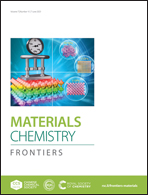Tin-based organic–inorganic metal halides with a reversible phase transition and thermochromic response†
Abstract
Organic–inorganic hybrid metal halides have been extensively studied since they have excellent photoelectric properties, diverse constituents, and tunable band gaps. However, most of the discoveries are random and there is a lack of new systems to find something worth exploring. Here, we have successfully synthesized two tin-based organic–inorganic hybrid halides (BPA)2SnCl6 (1, BPA-Cl) and (BPA)2SnBr6 (2, BPA-Br) (BPA = 3-bromopropan-1-ammonium) with a reversible dielectric switching response using halogen modulation. Differential scanning calorimetry (DSC) and dielectric measurements determined the phase transition temperatures (Tc) to be 1 (284.24 K) and 2 (301.89 K), and the Tc increased with halogen ion size. According to the 2D fingerprinting of Hirshfeld surface plots, the short mean (di, de) also changes with the variation of the inorganic framework, which is in accordance with DSC and dielectric results. The UV-NIR-vis absorption spectra reveal that 1 is a direct bandgap semiconductor (2.97 eV) and 2 is an indirect bandgap semiconductor (2.66 eV). In addition, compound 2 exhibits a fascinating reversible thermochromic response. This work not only provides a new systematic approach to synthesizing dielectric materials, but also proposes a route to obtain narrow-bandgap optoelectronic semiconductors.

- This article is part of the themed collections: FOCUS: Perovskite Materials and Devices and 2023 Materials Chemistry Frontiers HOT articles


 Please wait while we load your content...
Please wait while we load your content...